Analysis of Data Governance Technologies and Business Benefits
VerifiedAdded on 2022/08/21
|7
|1429
|18
Homework Assignment
AI Summary
This assignment solution delves into the concept and significance of data governance, emphasizing its role in managing data usability, availability, security, and integrity within organizations. The solution analyzes the data governance strategies of IBM and McKinsey & Company, highlighting their selection and implementation of technologies like Alfresco One and Collibra, respectively. It examines the business factors considered before technology implementation, such as data consistency, accuracy, and quality, along with the deficiencies addressed. The solution outlines the benefits achieved, including improved decision-making, operational efficiency, and data understandability, while also addressing the cost-effectiveness of these technologies. References from various sources are provided to support the analysis.
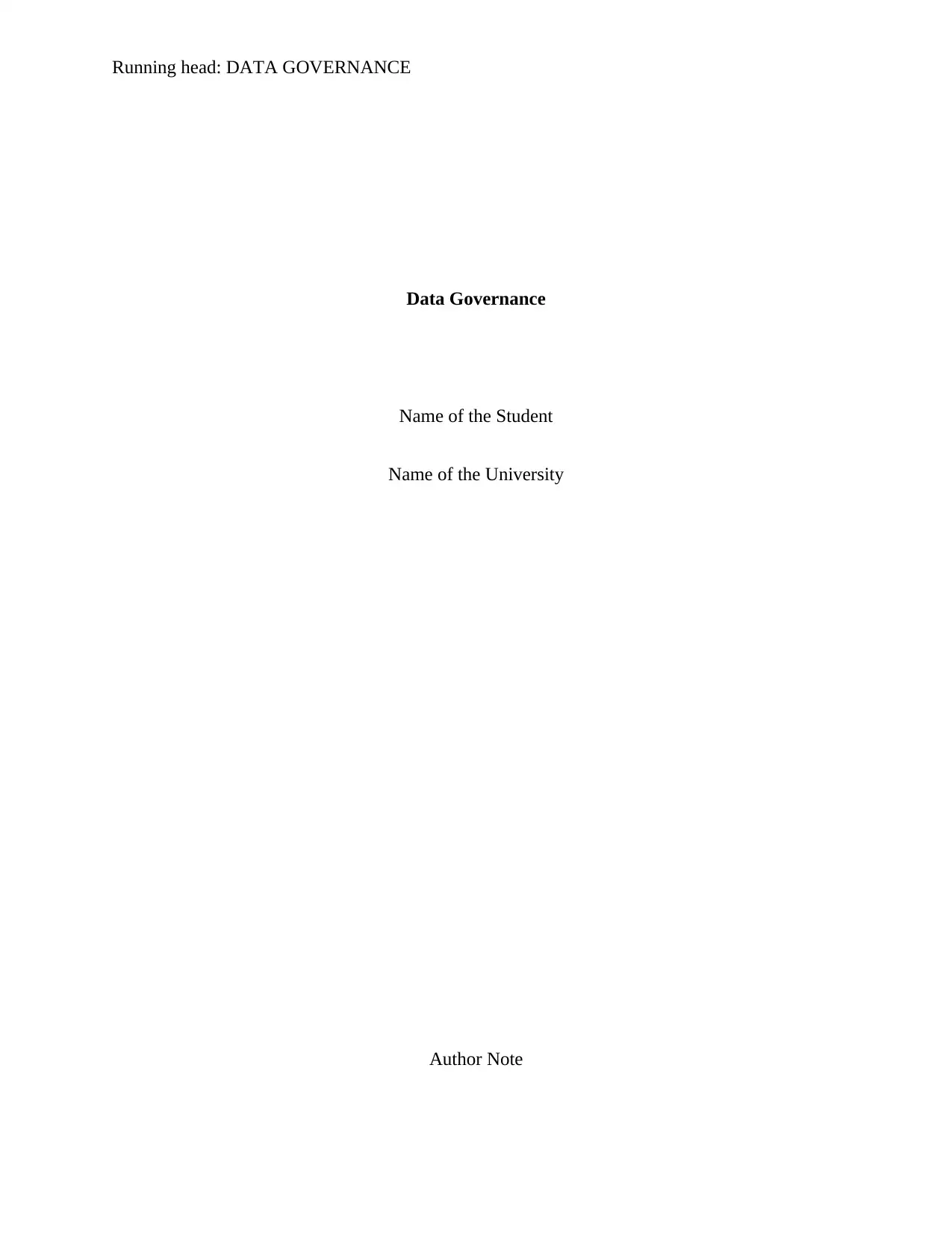
Running head: DATA GOVERNANCE
Data Governance
Name of the Student
Name of the University
Author Note
Data Governance
Name of the Student
Name of the University
Author Note
Paraphrase This Document
Need a fresh take? Get an instant paraphrase of this document with our AI Paraphraser
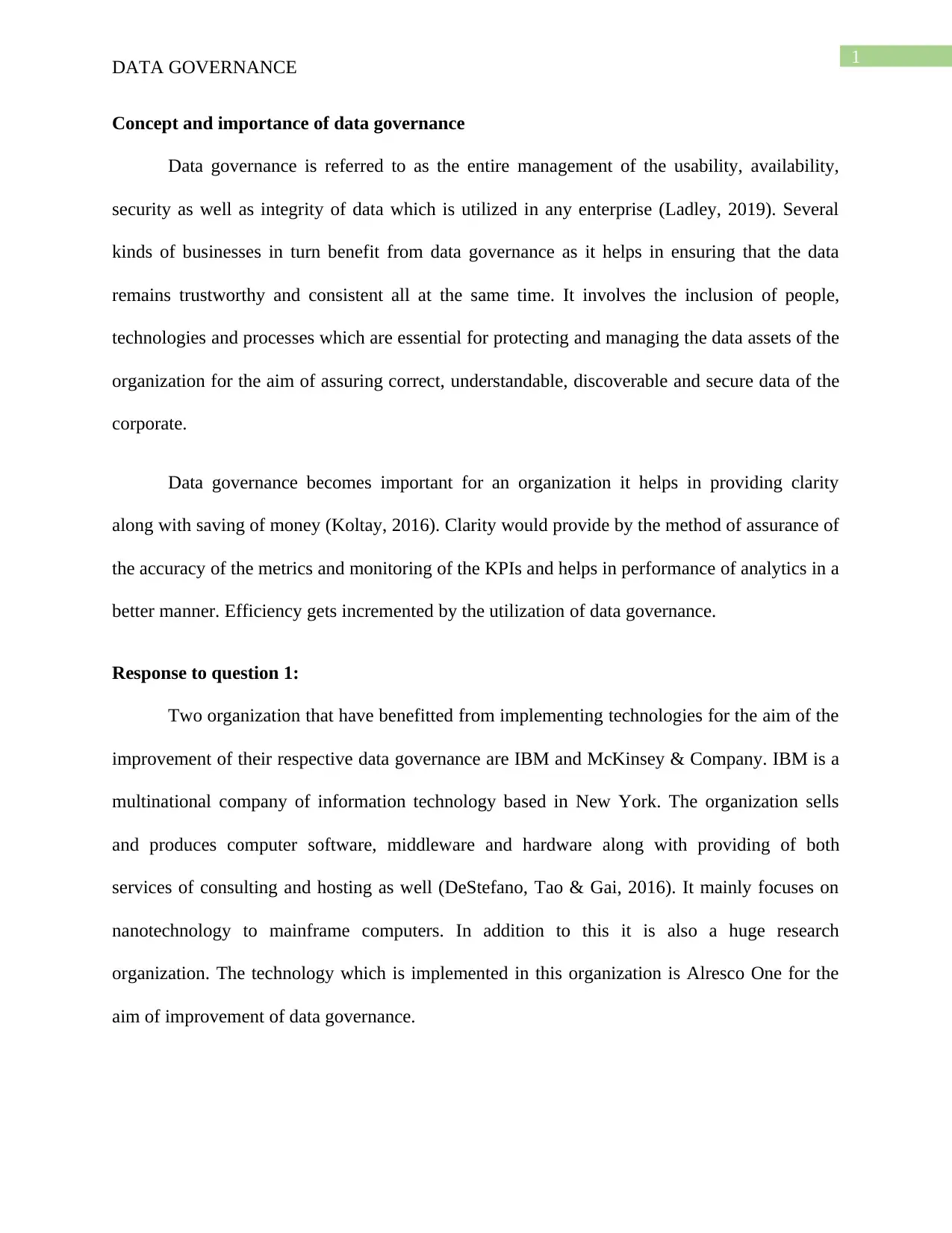
1
DATA GOVERNANCE
Concept and importance of data governance
Data governance is referred to as the entire management of the usability, availability,
security as well as integrity of data which is utilized in any enterprise (Ladley, 2019). Several
kinds of businesses in turn benefit from data governance as it helps in ensuring that the data
remains trustworthy and consistent all at the same time. It involves the inclusion of people,
technologies and processes which are essential for protecting and managing the data assets of the
organization for the aim of assuring correct, understandable, discoverable and secure data of the
corporate.
Data governance becomes important for an organization it helps in providing clarity
along with saving of money (Koltay, 2016). Clarity would provide by the method of assurance of
the accuracy of the metrics and monitoring of the KPIs and helps in performance of analytics in a
better manner. Efficiency gets incremented by the utilization of data governance.
Response to question 1:
Two organization that have benefitted from implementing technologies for the aim of the
improvement of their respective data governance are IBM and McKinsey & Company. IBM is a
multinational company of information technology based in New York. The organization sells
and produces computer software, middleware and hardware along with providing of both
services of consulting and hosting as well (DeStefano, Tao & Gai, 2016). It mainly focuses on
nanotechnology to mainframe computers. In addition to this it is also a huge research
organization. The technology which is implemented in this organization is Alresco One for the
aim of improvement of data governance.
DATA GOVERNANCE
Concept and importance of data governance
Data governance is referred to as the entire management of the usability, availability,
security as well as integrity of data which is utilized in any enterprise (Ladley, 2019). Several
kinds of businesses in turn benefit from data governance as it helps in ensuring that the data
remains trustworthy and consistent all at the same time. It involves the inclusion of people,
technologies and processes which are essential for protecting and managing the data assets of the
organization for the aim of assuring correct, understandable, discoverable and secure data of the
corporate.
Data governance becomes important for an organization it helps in providing clarity
along with saving of money (Koltay, 2016). Clarity would provide by the method of assurance of
the accuracy of the metrics and monitoring of the KPIs and helps in performance of analytics in a
better manner. Efficiency gets incremented by the utilization of data governance.
Response to question 1:
Two organization that have benefitted from implementing technologies for the aim of the
improvement of their respective data governance are IBM and McKinsey & Company. IBM is a
multinational company of information technology based in New York. The organization sells
and produces computer software, middleware and hardware along with providing of both
services of consulting and hosting as well (DeStefano, Tao & Gai, 2016). It mainly focuses on
nanotechnology to mainframe computers. In addition to this it is also a huge research
organization. The technology which is implemented in this organization is Alresco One for the
aim of improvement of data governance.
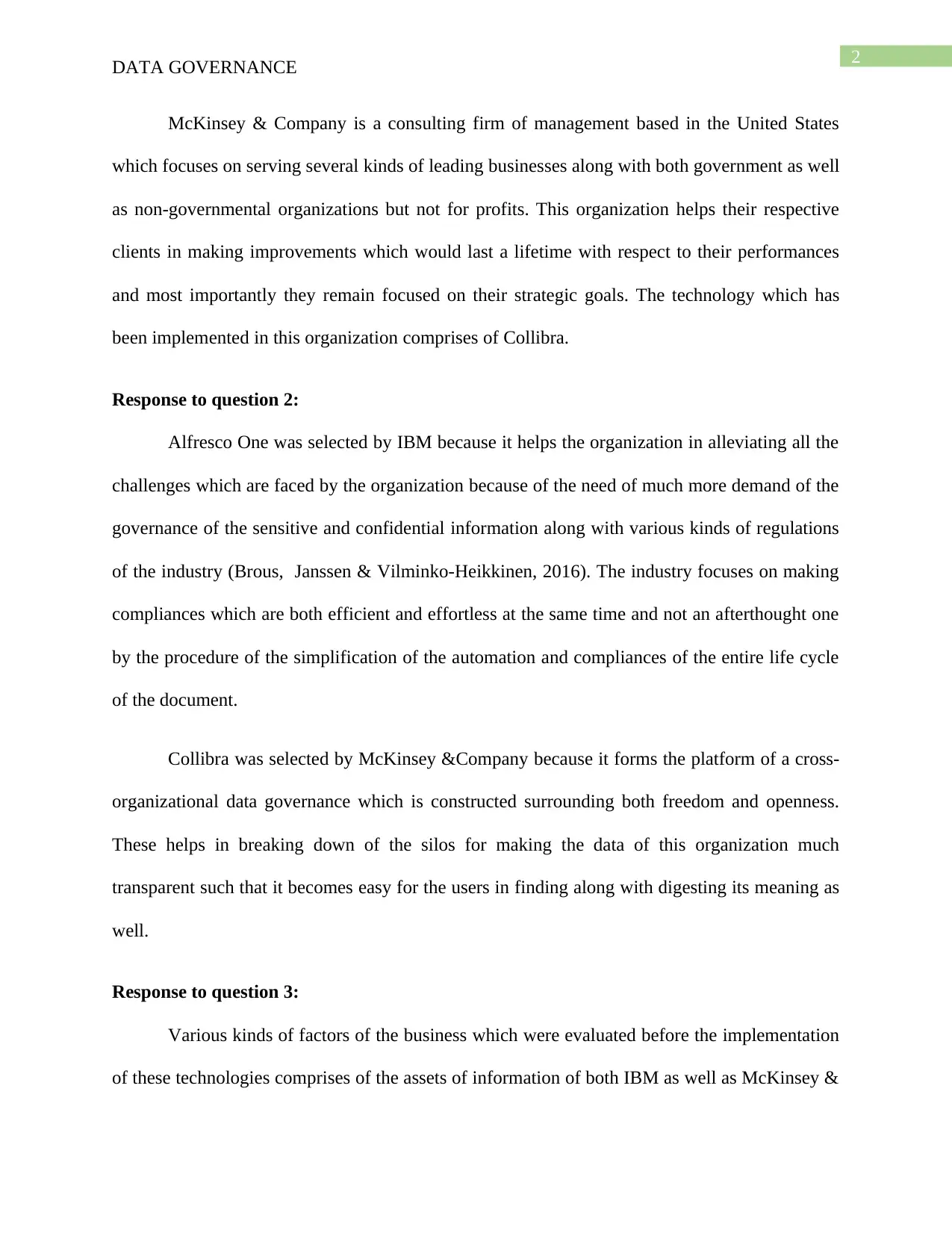
2
DATA GOVERNANCE
McKinsey & Company is a consulting firm of management based in the United States
which focuses on serving several kinds of leading businesses along with both government as well
as non-governmental organizations but not for profits. This organization helps their respective
clients in making improvements which would last a lifetime with respect to their performances
and most importantly they remain focused on their strategic goals. The technology which has
been implemented in this organization comprises of Collibra.
Response to question 2:
Alfresco One was selected by IBM because it helps the organization in alleviating all the
challenges which are faced by the organization because of the need of much more demand of the
governance of the sensitive and confidential information along with various kinds of regulations
of the industry (Brous, Janssen & Vilminko-Heikkinen, 2016). The industry focuses on making
compliances which are both efficient and effortless at the same time and not an afterthought one
by the procedure of the simplification of the automation and compliances of the entire life cycle
of the document.
Collibra was selected by McKinsey &Company because it forms the platform of a cross-
organizational data governance which is constructed surrounding both freedom and openness.
These helps in breaking down of the silos for making the data of this organization much
transparent such that it becomes easy for the users in finding along with digesting its meaning as
well.
Response to question 3:
Various kinds of factors of the business which were evaluated before the implementation
of these technologies comprises of the assets of information of both IBM as well as McKinsey &
DATA GOVERNANCE
McKinsey & Company is a consulting firm of management based in the United States
which focuses on serving several kinds of leading businesses along with both government as well
as non-governmental organizations but not for profits. This organization helps their respective
clients in making improvements which would last a lifetime with respect to their performances
and most importantly they remain focused on their strategic goals. The technology which has
been implemented in this organization comprises of Collibra.
Response to question 2:
Alfresco One was selected by IBM because it helps the organization in alleviating all the
challenges which are faced by the organization because of the need of much more demand of the
governance of the sensitive and confidential information along with various kinds of regulations
of the industry (Brous, Janssen & Vilminko-Heikkinen, 2016). The industry focuses on making
compliances which are both efficient and effortless at the same time and not an afterthought one
by the procedure of the simplification of the automation and compliances of the entire life cycle
of the document.
Collibra was selected by McKinsey &Company because it forms the platform of a cross-
organizational data governance which is constructed surrounding both freedom and openness.
These helps in breaking down of the silos for making the data of this organization much
transparent such that it becomes easy for the users in finding along with digesting its meaning as
well.
Response to question 3:
Various kinds of factors of the business which were evaluated before the implementation
of these technologies comprises of the assets of information of both IBM as well as McKinsey &
⊘ This is a preview!⊘
Do you want full access?
Subscribe today to unlock all pages.

Trusted by 1+ million students worldwide
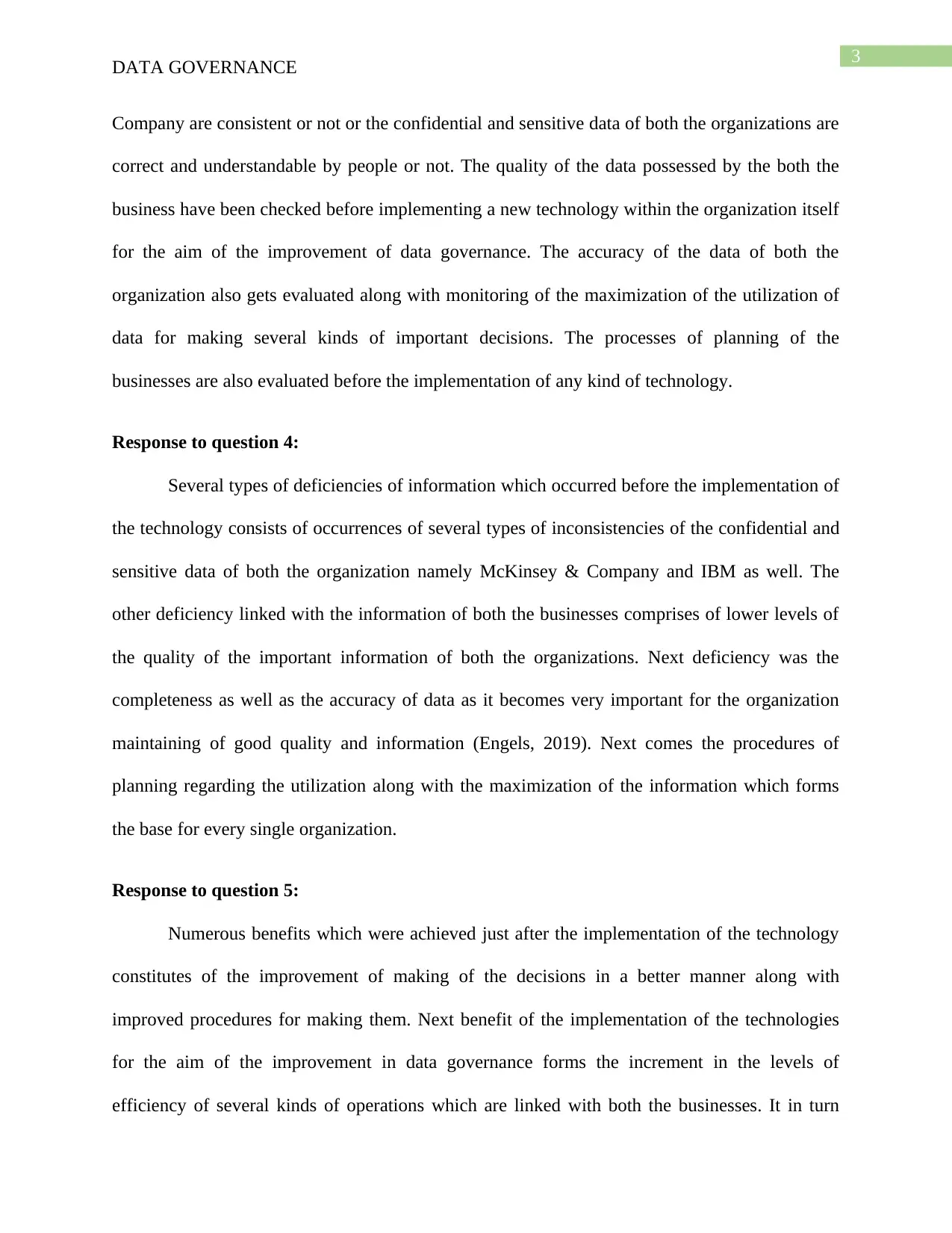
3
DATA GOVERNANCE
Company are consistent or not or the confidential and sensitive data of both the organizations are
correct and understandable by people or not. The quality of the data possessed by the both the
business have been checked before implementing a new technology within the organization itself
for the aim of the improvement of data governance. The accuracy of the data of both the
organization also gets evaluated along with monitoring of the maximization of the utilization of
data for making several kinds of important decisions. The processes of planning of the
businesses are also evaluated before the implementation of any kind of technology.
Response to question 4:
Several types of deficiencies of information which occurred before the implementation of
the technology consists of occurrences of several types of inconsistencies of the confidential and
sensitive data of both the organization namely McKinsey & Company and IBM as well. The
other deficiency linked with the information of both the businesses comprises of lower levels of
the quality of the important information of both the organizations. Next deficiency was the
completeness as well as the accuracy of data as it becomes very important for the organization
maintaining of good quality and information (Engels, 2019). Next comes the procedures of
planning regarding the utilization along with the maximization of the information which forms
the base for every single organization.
Response to question 5:
Numerous benefits which were achieved just after the implementation of the technology
constitutes of the improvement of making of the decisions in a better manner along with
improved procedures for making them. Next benefit of the implementation of the technologies
for the aim of the improvement in data governance forms the increment in the levels of
efficiency of several kinds of operations which are linked with both the businesses. It in turn
DATA GOVERNANCE
Company are consistent or not or the confidential and sensitive data of both the organizations are
correct and understandable by people or not. The quality of the data possessed by the both the
business have been checked before implementing a new technology within the organization itself
for the aim of the improvement of data governance. The accuracy of the data of both the
organization also gets evaluated along with monitoring of the maximization of the utilization of
data for making several kinds of important decisions. The processes of planning of the
businesses are also evaluated before the implementation of any kind of technology.
Response to question 4:
Several types of deficiencies of information which occurred before the implementation of
the technology consists of occurrences of several types of inconsistencies of the confidential and
sensitive data of both the organization namely McKinsey & Company and IBM as well. The
other deficiency linked with the information of both the businesses comprises of lower levels of
the quality of the important information of both the organizations. Next deficiency was the
completeness as well as the accuracy of data as it becomes very important for the organization
maintaining of good quality and information (Engels, 2019). Next comes the procedures of
planning regarding the utilization along with the maximization of the information which forms
the base for every single organization.
Response to question 5:
Numerous benefits which were achieved just after the implementation of the technology
constitutes of the improvement of making of the decisions in a better manner along with
improved procedures for making them. Next benefit of the implementation of the technologies
for the aim of the improvement in data governance forms the increment in the levels of
efficiency of several kinds of operations which are linked with both the businesses. It in turn
Paraphrase This Document
Need a fresh take? Get an instant paraphrase of this document with our AI Paraphraser
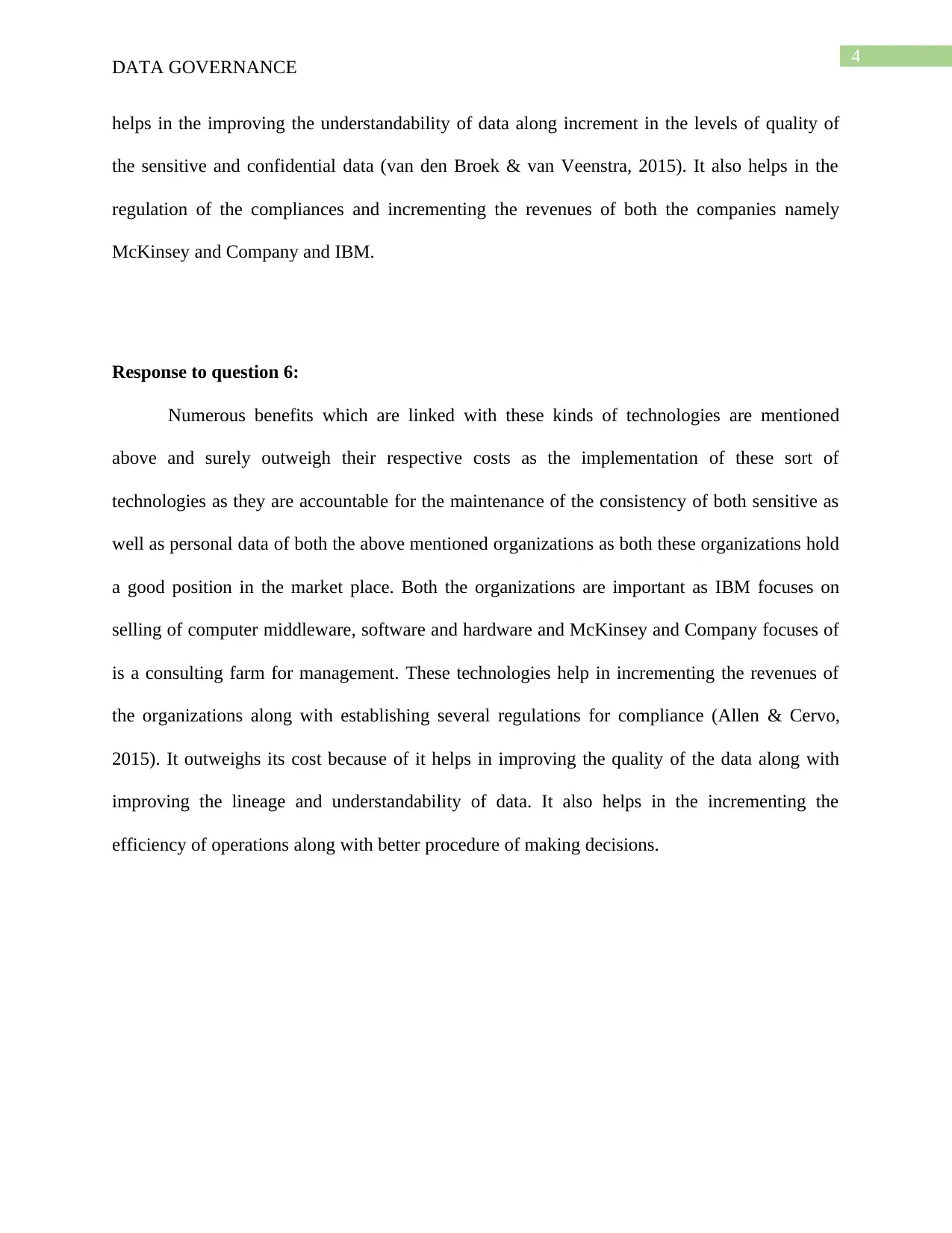
4
DATA GOVERNANCE
helps in the improving the understandability of data along increment in the levels of quality of
the sensitive and confidential data (van den Broek & van Veenstra, 2015). It also helps in the
regulation of the compliances and incrementing the revenues of both the companies namely
McKinsey and Company and IBM.
Response to question 6:
Numerous benefits which are linked with these kinds of technologies are mentioned
above and surely outweigh their respective costs as the implementation of these sort of
technologies as they are accountable for the maintenance of the consistency of both sensitive as
well as personal data of both the above mentioned organizations as both these organizations hold
a good position in the market place. Both the organizations are important as IBM focuses on
selling of computer middleware, software and hardware and McKinsey and Company focuses of
is a consulting farm for management. These technologies help in incrementing the revenues of
the organizations along with establishing several regulations for compliance (Allen & Cervo,
2015). It outweighs its cost because of it helps in improving the quality of the data along with
improving the lineage and understandability of data. It also helps in the incrementing the
efficiency of operations along with better procedure of making decisions.
DATA GOVERNANCE
helps in the improving the understandability of data along increment in the levels of quality of
the sensitive and confidential data (van den Broek & van Veenstra, 2015). It also helps in the
regulation of the compliances and incrementing the revenues of both the companies namely
McKinsey and Company and IBM.
Response to question 6:
Numerous benefits which are linked with these kinds of technologies are mentioned
above and surely outweigh their respective costs as the implementation of these sort of
technologies as they are accountable for the maintenance of the consistency of both sensitive as
well as personal data of both the above mentioned organizations as both these organizations hold
a good position in the market place. Both the organizations are important as IBM focuses on
selling of computer middleware, software and hardware and McKinsey and Company focuses of
is a consulting farm for management. These technologies help in incrementing the revenues of
the organizations along with establishing several regulations for compliance (Allen & Cervo,
2015). It outweighs its cost because of it helps in improving the quality of the data along with
improving the lineage and understandability of data. It also helps in the incrementing the
efficiency of operations along with better procedure of making decisions.
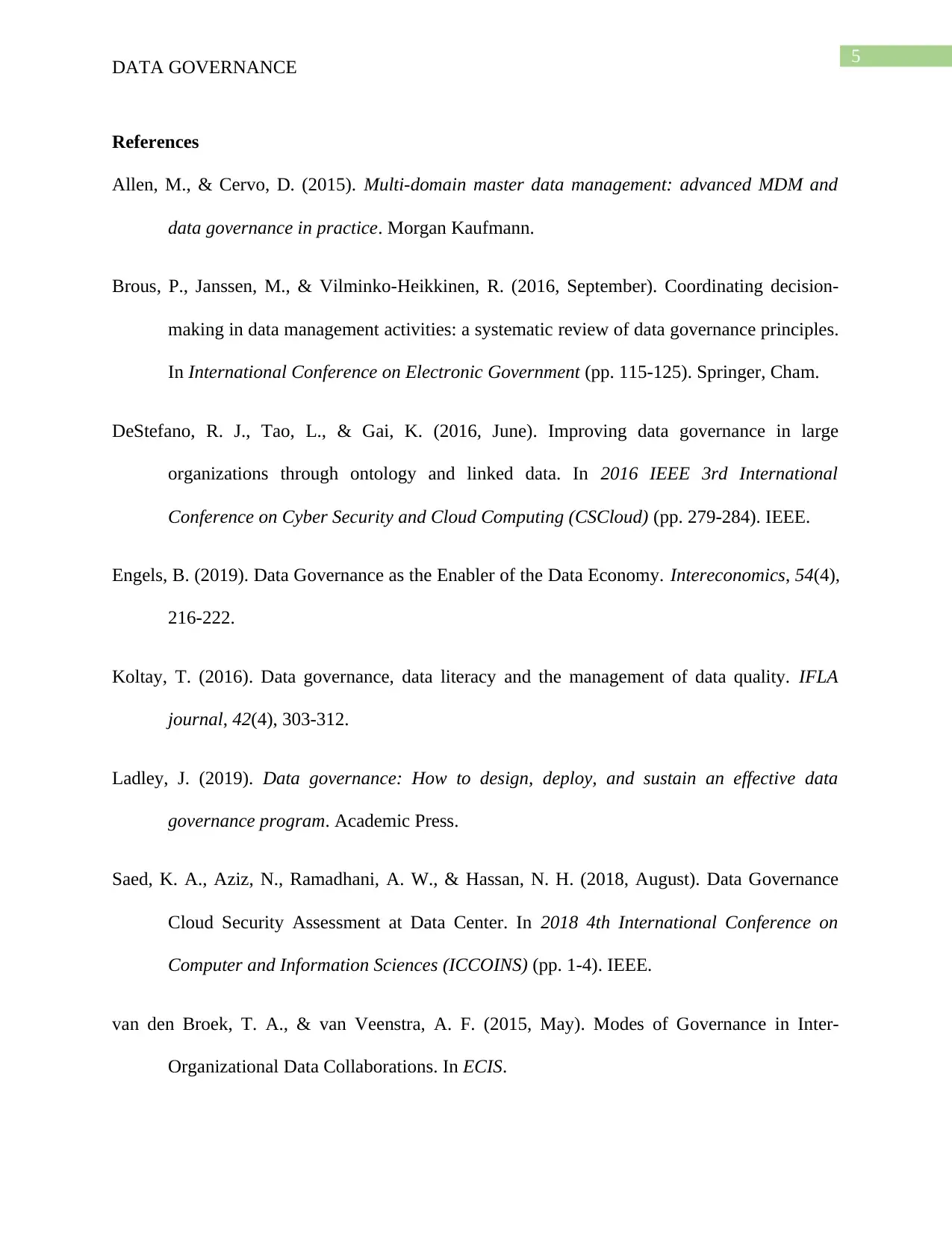
5
DATA GOVERNANCE
References
Allen, M., & Cervo, D. (2015). Multi-domain master data management: advanced MDM and
data governance in practice. Morgan Kaufmann.
Brous, P., Janssen, M., & Vilminko-Heikkinen, R. (2016, September). Coordinating decision-
making in data management activities: a systematic review of data governance principles.
In International Conference on Electronic Government (pp. 115-125). Springer, Cham.
DeStefano, R. J., Tao, L., & Gai, K. (2016, June). Improving data governance in large
organizations through ontology and linked data. In 2016 IEEE 3rd International
Conference on Cyber Security and Cloud Computing (CSCloud) (pp. 279-284). IEEE.
Engels, B. (2019). Data Governance as the Enabler of the Data Economy. Intereconomics, 54(4),
216-222.
Koltay, T. (2016). Data governance, data literacy and the management of data quality. IFLA
journal, 42(4), 303-312.
Ladley, J. (2019). Data governance: How to design, deploy, and sustain an effective data
governance program. Academic Press.
Saed, K. A., Aziz, N., Ramadhani, A. W., & Hassan, N. H. (2018, August). Data Governance
Cloud Security Assessment at Data Center. In 2018 4th International Conference on
Computer and Information Sciences (ICCOINS) (pp. 1-4). IEEE.
van den Broek, T. A., & van Veenstra, A. F. (2015, May). Modes of Governance in Inter-
Organizational Data Collaborations. In ECIS.
DATA GOVERNANCE
References
Allen, M., & Cervo, D. (2015). Multi-domain master data management: advanced MDM and
data governance in practice. Morgan Kaufmann.
Brous, P., Janssen, M., & Vilminko-Heikkinen, R. (2016, September). Coordinating decision-
making in data management activities: a systematic review of data governance principles.
In International Conference on Electronic Government (pp. 115-125). Springer, Cham.
DeStefano, R. J., Tao, L., & Gai, K. (2016, June). Improving data governance in large
organizations through ontology and linked data. In 2016 IEEE 3rd International
Conference on Cyber Security and Cloud Computing (CSCloud) (pp. 279-284). IEEE.
Engels, B. (2019). Data Governance as the Enabler of the Data Economy. Intereconomics, 54(4),
216-222.
Koltay, T. (2016). Data governance, data literacy and the management of data quality. IFLA
journal, 42(4), 303-312.
Ladley, J. (2019). Data governance: How to design, deploy, and sustain an effective data
governance program. Academic Press.
Saed, K. A., Aziz, N., Ramadhani, A. W., & Hassan, N. H. (2018, August). Data Governance
Cloud Security Assessment at Data Center. In 2018 4th International Conference on
Computer and Information Sciences (ICCOINS) (pp. 1-4). IEEE.
van den Broek, T. A., & van Veenstra, A. F. (2015, May). Modes of Governance in Inter-
Organizational Data Collaborations. In ECIS.
⊘ This is a preview!⊘
Do you want full access?
Subscribe today to unlock all pages.

Trusted by 1+ million students worldwide

6
DATA GOVERNANCE
DATA GOVERNANCE
1 out of 7
Related Documents
Your All-in-One AI-Powered Toolkit for Academic Success.
+13062052269
info@desklib.com
Available 24*7 on WhatsApp / Email
![[object Object]](/_next/static/media/star-bottom.7253800d.svg)
Unlock your academic potential
Copyright © 2020–2025 A2Z Services. All Rights Reserved. Developed and managed by ZUCOL.





